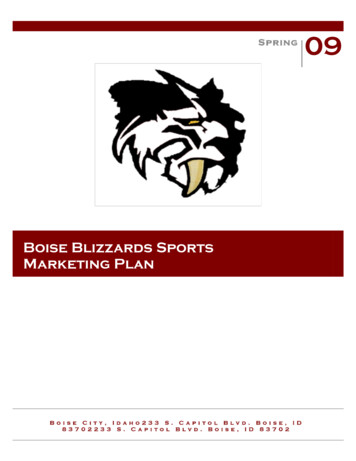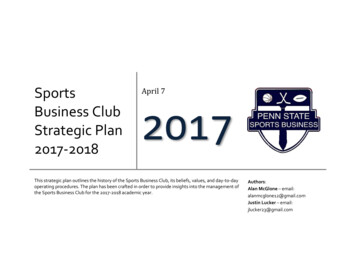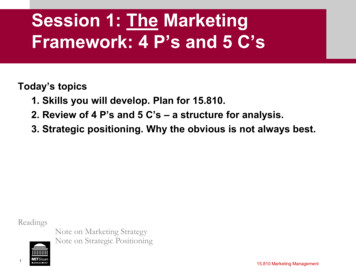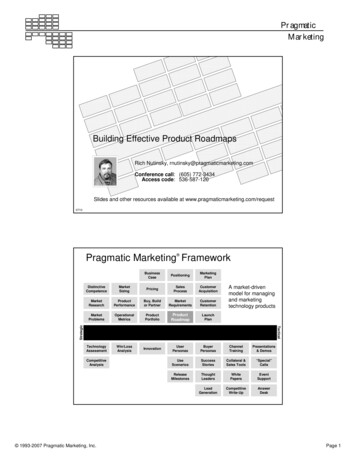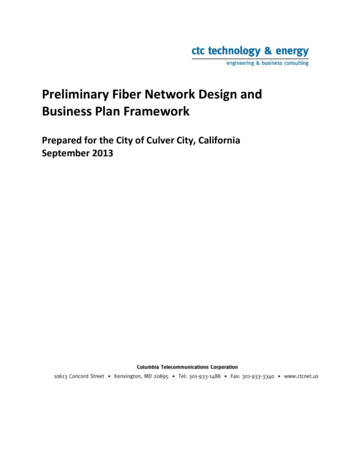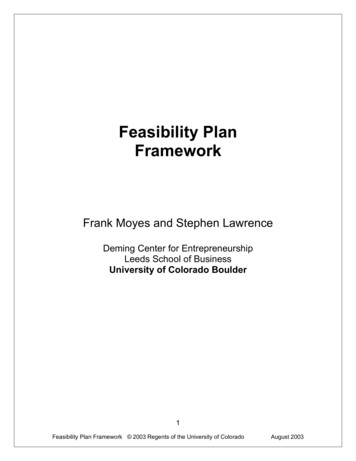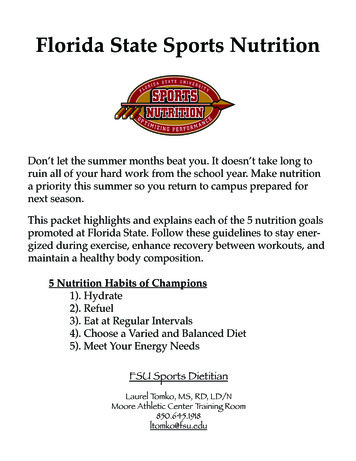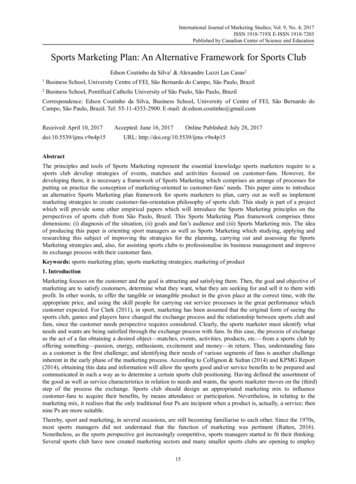
Transcription
International Journal of Marketing Studies; Vol. 9, No. 4; 2017ISSN 1918-719X E-ISSN 1918-7203Published by Canadian Center of Science and EducationSports Marketing Plan: An Alternative Framework for Sports ClubEdson Coutinho da Silva1 & Alexandre Luzzi Las Casas21Business School, University Centre of FEI, São Bernardo do Campo, São Paulo, Brazil2Business School, Pontifical Catholic University of São Paulo, São Paulo, BrazilCorrespondence: Edson Coutinho da Silva, Business School, University of Centre of FEI, São Bernardo doCampo, São Paulo, Brazil. Tel: 55-11-4353-2900. E-mail: dr.edson.coutinho@gmail.comReceived: April 10, 2017doi:10.5539/ijms.v9n4p15Accepted: June 16, 2017Online Published: July 28, 2017URL: http://doi.org/10.5539/ijms.v9n4p15AbstractThe principles and tools of Sports Marketing represent the essential knowledge sports marketers require to asports club develop strategies of events, matches and activities focused on customer-fans. However, fordeveloping them, it is necessary a framework of Sports Marketing which comprises an arrange of processes forputting on practice the conception of marketing-oriented to customer-fans’ needs. This paper aims to introducean alternative Sports Marketing plan framework for sports marketers to plan, carry out as well as implementmarketing strategies to create customer-fan-orientation philosophy of sports club. This study is part of a projectwhich will provide some other empirical papers which will introduce the Sports Marketing principles on theperspectives of sports club from São Paulo, Brazil. This Sports Marketing Plan framework comprises threedimensions: (i) diagnosis of the situation, (ii) goals and fan’s audience and (iii) Sports Marketing mix. The ideaof producing this paper is orienting sport managers as well as Sports Marketing which studying, applying andresearching this subject of improving the strategies for the planning, carrying out and assessing the SportsMarketing strategies and, also, for assisting sports clubs to professionalise its business management and improveits exchange process with their customer fans.Keywords: sports marketing plan; sports marketing strategies; marketing of product1. IntroductionMarketing focuses on the customer and the goal is attracting and satisfying them. Then, the goal and objective ofmarketing are to satisfy customers, determine what they want, what they are seeking for and sell it to them withprofit. In other words, to offer the tangible or intangible product in the given place at the correct time, with theappropriate price, and using the skill people for carrying out service processes in the great performance whichcustomer expected. For Clark (2011), in sport, marketing has been assumed that the original form of seeing thesports club, games and players have changed the exchange process and the relationship between sports club andfans, since the customer needs perspective requires considered. Clearly, the sports marketer must identify whatneeds and wants are being satisfied through the exchange process with fans. In this case, the process of exchangeas the act of a fan obtaining a desired object—matches, events, activities, products, etc.—from a sports club byoffering something—passion, energy, enthusiasm, excitement and money—in return. Thus, understanding fansas a customer is the first challenge; and identifying their needs of various segments of fans is another challengeinherent in the early phase of the marketing process. According to Collignon & Sultan (2014) and KPMG Report(2014), obtaining this data and information will allow the sports good and/or service benefits to be prepared andcommunicated in such a way as to determine a certain sports club positioning. Having defined the assortment ofthe good as well as service characteristics in relation to needs and wants, the sports marketer moves on the (third)step of the process the exchange. Sports club should design an appropriated marketing mix to influencecustomer-fans to acquire their benefits, by means attendance or participation. Nevertheless, in relating to themarketing mix, it realises that the only traditional four Ps are incipient when a product is, actually, a service; thennine Ps are more suitable.Thereby, sport and marketing, in several occasions, are still becoming familiarise to each other. Since the 1970s,most sports managers did not understand that the function of marketing was pertinent (Ratten, 2016).Nonetheless, as the sports perspective got increasingly competitive, sports managers started to fit their thinking.Several sports club have now created marketing sectors and many smaller sports clubs are opening to employ15
ijms.ccsenet.orgInternational Journal of Marketing StudiesVol. 9, No. 4; 2017marketing skills to manage the get advantage of marketing in the designing process (The Future of Sports, 2015).This article aims to introduce a Sports Marketing plan framework for sports marketers to plan, carry out as wellas implement marketing strategies to create customer-fan-orientation philosophy of sports club. This frameworkwas conceived to comprise three levels: diagnosis of the situation, goals and fan’s audience and marketing mix.These authors proposed this framework to assist sports marketers in improving new marketing strategiesconsidering not only a mere fan, but a customer. Because fans fall in love and admire their sports club and team,i.e., it is up to the sports club creating conditions so that their fans consume products and services and want to bea fan member, through relationships which provide for both exclusive benefits. Therefore, this paper aims tocontribute to the art of marketing applied to the sports club to foment more knowledge, discussion, and debatesaround the topic.2. Sports Marketing OverviewThe term “Sports Marketing” was first used in the United States by Advertising Age in 1978. Sports Marketing isan important aspect of global sports innovation as it is relevant to the business growth as well as survival. Itobserves that umpteen sports teams help with corporate sponsors around of the world through their globalmarketing campaigns (Shilbury, 2009). Chadwick & Thwaites (2005) understand that Sports Marketing as aprocess by means which a contest with a doubtful result is arranged opening the chance for the concomitantfulfilment of objectives among sports customers-fans, sports businesses, participants and other associated people,bunches and organisations. From an international view, Sports Marketing is prescribed further as the chance for acompany or an organisation to communicate their services in a sport-oriented context. This should contain thehiring the naming rights to a sports stadium, sponsoring players are offering clothing and sports equipment.It notes that Sports Marketing has been developed to both the promotion of sports events and teams as well asthe promotion of other products and services in relation to sports events. Mason (1999) has discussed the role ofthe sports products and customers-supporters. From a business perspective, the goal is to provide businesscompanies with strategies to promote the sport or to promote products and services through sports events. Thus,the primary sports product can be both tangible as well as intangible in nature. Although this may be true,businesses and companies use sports as an alternative to achieve their customers and to sell their products and/orservices. Indeed, Bernstein (2015) point out that Sports Marketing management needs to be able to marketproducts to both sides of this relationship, i.e., an exchange process. Another challenge is that individuals oftenhave both positive and negative personal views—or perceptions—with elements of the sports product. In abusiness context, the manufacturer is normally considered as the expert of a product. Nevertheless, when itcomes to the sport, the customer believes they are the expert.In general, Sports Marketing is characterised as a social and managerial process by which the sports managerslook for obtaining what sporting companies require and desire through creating and exchanging products andbenefits with people and other companies (Shilbury, 2009). Fullerton & Merz (2008) introduce another view, thatSports Marketing is the activity of planning and implementing processes for production, pricing, promotion anddistribution of sports products to satisfy the needs or desires of customers to achieve the organisation’s results.For Smith & Westerbeek (2003), Sports Marketing must have focused on Marketing of Sports products as a basisfor the creation of revenue for sport organisations while designing marketing plans that will lead forpotentialising of revenues accruing to a sport organisation; and they still include Marketing through Sportsreferring to Sports clubs such players, teams and programs the organisation’s marketing plan. In this context, twodistinct streams exist within the broad concept of Sports Marketing: Marketing of Sports and Marketing ThroughSports.Marketing of Sports includes marketing sporting events and equipment to fans and participants. This sort ofSports Marketing is intrinsic in the introduction of new sports such as action sports and innovative new sportsproducts (Fullerton & Merz, 2008). Marketing through sport is considered sport as communications media or asponsorship alternative for organisations that market customers, and to a lesser extent, enterprise products. WhileMarketing of Sports is an approach to marketing activities and processes to market goods as well as servicestoward to sports fans and spectators; Marketing through Sports means the promotion of non-sporting productsand/or services at sporting events and the use of players to support non-sport products and/or services (Fullerton& Merz, 2008; Ratten & Ratten, 2011; Rundh & Gottfridsson, 2015; Shilbury, 2009). Thereby, Sports Marketingconsists of all activities designed to meet needs and wants of sports customers through exchange processes.Sports Marketing has designed two major thrusts: First, the Marketing of Sports products and/or servicestowards to fans of the sport. Second, the marketing of other customer and enterprise products or servicesconsidering sports promotions (Mason, 1999).16
ijms.ccsenet.orgInternational Journal of Marketing StudiesVol. 9, No. 4; 2017By the large, professionals need to know three different dimensions of Sports Marketing: (i) advertising inrelation to sport and sport associations such the Olympics, Sports Leagues—as British Premier League, etc.;which can be labelled “Marketing of Sports”; (ii) promotion of sport in relation to the public to increase theparticipation at sport events or other kinds of arrangements, it means, product which is created by professionalsports leagues. Several means are used, such as sponsorships for the promotion of teams or athletes, TV andradio advertisement, advertisement in relation to the sports event and celebrations (Shilbury & Rentschler, 2007).For Fullerton & Merz (2008), other means are billboards in the streets and promotions and publicity duringmajor sporting events; (iii) promoting of products in relation to sports events such as “Marketing ThroughSports”. In this sponsorship plays an important role. Sponsorship in relation to sports events is also an area thathas interested because a sponsorship is a powerful device for communicating with spectators at sports events andfans watching events on TV at home. Therefore, the marketing of sports products may provoke a positive ideathrough the inclusion of the sponsorship of an admirable sports property take into account an appropriatecommunication plan (Collignon & Sultan, 2014; Rundh & Gottfridsson, 2015).Sports Marketing capitalises on the popularity of sports. Sports marketers research the demographics andconsumption habits of fans to get more revenues on the items customers-fans obtain or buy the good and/orservices related to sporting events. The price fans are willing to afford for a ticket depends upon the emergenceof the market, the national (or international) relevance of the match, the talent of the involved players, and thecompetition linked with the league or tournament. Fans are usually buying team identified clothing or equipmentand for the costs of food and travel to and from a match. The goal of Sports Marketing is to apply, then suitablemarketing mix to achieve customers-fans meet their needs while providing a revenue (Shilbury & Rentschler,2007). In summary, marketing-driven strategies enable to the sport to respond better to the fans/customers’ needsand to reach even more fans. The sport has turned in to be entertainment and economic success in becoming amore central element in sport. The sports business has also become increasingly more customer-oriented.3. Sports Marketing Plan: Proposal of a ModelBefore addressing what, a Sports Marketing Plan encompasses, it is helpful to approach the structure hierarchicalof Sports Marketing concept. There are four levels, which need be considered. At the most fundamental level,Sports Marketing embraces a general philosophy or a set of beliefs about marketing performance in anorganisation. It is not only sports marketers and marketing sector of sports entity that are responsible formarketing activities and processes. A marketing philosophy means putting the needs and wants of a customer-fanin the centre of the decision-making (Silva & Mazzon, 2016). It is relevant to include that the needs of thecustomer-fans must complement the objectives of the sports entities. In business, the objective is usually to winor attract attention to the sports entity. Marketing principles involve generating a win-win exchange process forboth the sports club and customer-fans, but it realises that no one will win if customer-fans’ expectation is notachieved (Blumrodt, Desbordes & Bodin, 2013).17
ijms.ccsenet.orgInternational Journal of Marketing StudiesVol. 9, No. 4; 2017Figure 1. Sports marketing planSource: authors.At a second level, Sports Marketing involves processes and/or steps. It is a process because it requires severalactivities as well as stages, required to find opportunities, devise a strategy, plan the tactics, and implement andevaluate a Sports Marketing Plan. These processes are a common property of Sports Marketing and feature as18
ijms.ccsenet.orgInternational Journal of Marketing StudiesVol. 9, No. 4; 2017the structural framework. At the third level, Sports Marketing has been described as a set of principles, since itadopts concepts that provide specific guidance to those undertaking Sports Marketing tasks. In other words,principles aim to provide clear guidance as to how the process of Sports Marketing can be used in practice.Finally, at the most operational level, Sports Marketing implements the arrange of tools, which are analyticaldevices and given activities applied in day-to-day practices. Then, Sports Marketing may be summarised as aphilosophy based on some commercial strategies which involve some processes, a set of general rules andguidelines as well as tools for managing customer relationship (Mastermann, 2004; Maltese & Danglade, 2014).In order to assist to “art” of Sports Marketing as well as figure out new opportunities to undertake newinnovations and solutions in the sport arena, these authors propose a Sports Marketing Plan framework, forunderstanding the step-by-step required to set up sport products, services and events in view to respond the sportcustomer-fans’ claims in terms of efficient, effective and marketing orientation from a sports club. Thisframework has several processes which are grouped into three levels: (i) diagnosis: whose function is a set ofactivities to research, collect and analyse data from external and internal environments, factors which affectingthe fan’s behaviour and SWOT (Strong, Weakness, Opportunity and Threat) analyses to diagnosis the realsituation; (ii) Fans: it encompasses the goals and objects of marketing plan, selecting and defining the targetcustomer-fans audience and positioning the value position and brand on the market, which it will guide theSports Marketing strategies; (iii) Sports Marketing Mix: the tools that will provide and ensure mechanisms tomeasure, analysis and asses of results as well as sponsorship and partners, in which they will sponsor, developand work together to the extent of the sports club team (Mastermann, 2004; Shilbury, 2009). In this next subtopic,these authors will explain all the process on the three levels to develop a Sports Marketing Plan, see figure 1.3.1 Diagnosis of the SituationThe first process is the mission of Sports Marketing Plan. A mission statement describes directions for the sportsclub, determining and explaining its meaning and reason for existence. To be unique as well as singular, amission statement should distinctly answer “What is our market plan?”. The mission statement must be clear andconcise in view to assist in produce common sense about the purpose as well as guide decision-making andresources allocation in the future. In this sense, the mission statement of the Sports Marketing Plan must include:answering the interest of the sports club; specifying the needs that the sports club’s focus on; incorporating thevalues of sponsorship; describing and identifying the advantage of the sports club; introducing the real objectiveand trend of sports club in long term; and defining the sports club craves in the long term. Therefore, thepowerful mission of sports club requires a set of elements: (i) strategic purpose, a set of sports goals of benefitsdesigned by sport marketers; (ii) organisation principles, approaching moral and ethical issues to toward theSports Marketing Plan; (iii) valuable competencies, expressing fulfilment; (iv) target segment, through severalactivities and processes customer-fan oriented; (v) positioning, the image related to benefits of sports club.Hence, the mission statement is an abstraction of strategic vision (Silva & Mazzon, 2016).The second and third processes refer to outside and inside environment. Silva & Mazzon (2016) state that theenvironmental factors (or variables) requiring consideration, which are the forces that affect sports clubindirectly. Such forces influence and impact of the sports marketers’ decision-making in towards to plan, developand maintain marketing activities driven to the target audience. Outside environment consists of farthestvariables of the sports club, which are represented by technology, demographic and social trends, economicissues, political legislation, natural and sustainable concerns. Inside environment is closest variables, such:resources, competencies, capacity of providing services, customer-oriented culture of the sports club,departments performance, suppliers and outsourcing, sponsorships, marketing channels (point of sale, financialcompanies, communication companies) and publics (see figure 2). Sports marketers have chances to interact,handle and take some decisions in inside environment. Having deep knowledge about outside and insideenvironments besides markets research allow for sporting marketers mitigate risks eventual with purpose toimprove efficient and effective related to processes and decision-making managed for sport marketers, in view toaddress solution to customer-fans.The fourth process involves the sports club competition, based on Porter’s competitive forces model. ForMastermann (2004), Shilbury (2009) and Kosík (2011), Porter’s model describes five forces that sport marketersshould review when examining competition and the attractiveness lined up for a sports club: (i) intensity ofcompetition between existing sports clubs for winning a league; (ii) bargaining power of buyers refer to processto bargain products, services and events to fans, spectators, members, sponsors, etc; (iii) threats of substituteproducts means other sort of product, services or events from c
Marketing of Sports includes marketing sporting events and equipment to fans and participants. This sort of Sports Marketing is intrinsic in the introduction of new sports such as action sports and innovative new sports products (Fullerton & Merz, 2008). Marketing through sport is consi
